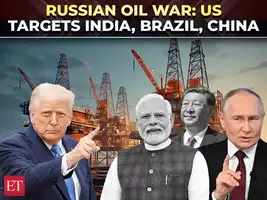
What if every drop of oil you bought came with a geopolitical ultimatum? India just found out.
Oil Turns Political: The World’s Cheapest Fuel Comes at a Diplomatic Price
Before examining the political landscape, it is important to understand what kind of oil India buys and why.
India is the third-largest oil consumer in the world, yet it produces only a fraction of its domestic needs. To meet its vast energy demands—for petrol, diesel, LPG, and aviation fuel—India imports approximately 85% of its crude oil. This raw petroleum is then refined domestically and powers everything from vehicles and factories to homes and businesses.
When the Russia–Ukraine war began, the global oil market shifted dramatically. Western nations banned or significantly reduced Russian oil imports. In response, Russia offered its Urals crude—a medium sour blend—at deeply discounted prices to non-Western buyers. India, grappling with the pressure of high inflation and global price shocks, saw this as a strategic opportunity.
Indian oil companies such as Indian Oil Corporation (IOCL) and Bharat Petroleum (BPCL) increased imports of Russian crude. The results were immediate:
- India saved billions on its oil import bill.
- Fuel prices remained relatively stable.
- The Indian economy gained some breathing room.
What began as a pragmatic economic decision soon attracted international scrutiny.
Why the World’s Largest Democracies Are Buying Russian Oil Anyway
The discounts were too substantial to ignore—and not just for India. China, Brazil, and several other nations also ramped up oil purchases from Russia. Collectively, these countries ensured that Russia’s oil revenues remained robust, despite Western sanctions.
India’s share of Russian oil imports rose from less than 1% in early 2022 to over 40% in 2024. For a developing country of 1.4 billion people, purchasing discounted oil was not about ideology—it was about economic survival and national development.
India has long followed a policy of strategic autonomy, building partnerships with major powers while retaining the freedom to make independent decisions based on national interest.
Thus, while the West aligned with Ukraine, India maintained its non-aligned position and continued its energy trade with Russia—legally and transparently.
America’s Fury: When Oil Purchases Become Acts of War
U.S. Senator Lindsey Graham made international headlines with a provocative statement. He accused India, China, and Brazil of enabling the Ukraine war by buying Russian oil and issued a stark warning:
“If they keep buying Russian oil, I will push for 100% tariffs on all goods they export to the United States.”
Graham’s remarks echoed the Trump-era approach of using trade penalties as leverage. This was not merely a caution—it was a threat of economic retaliation against countries that do not align with U.S. sanctions.
His central concern is that each dollar Russia earns from oil supports its military operations. While the U.S. and its allies attempt to financially isolate Moscow, energy trade undermines those efforts.
India, however, is not violating any international laws or sanctions. It is acting in accordance with its sovereign rights and purchasing energy at competitive rates. The United States may interpret this as geopolitical disobedience, but India views it as economic pragmatism, not provocation.
India’s Diplomatic Strike Back: You Cannot Dictate Our Energy Choices
India was quick to respond. Foreign Minister Dr. S. Jaishankar defended the country’s energy policy on global platforms:
“Europe has bought more Russian gas in one afternoon than India has in a month.”
India highlighted what it sees as Western double standards. While European nations continue to import Russian energy—albeit through indirect channels and third parties—India is being singled out for scrutiny.
Jaishankar emphasized that India’s foremost responsibility is to its citizens. The national priority is clear: ensure affordable fuel, support the economy, and preserve sovereignty in policymaking.
A New Cold War? Tariffs Could Trigger a Global Economic Split
Should the U.S. proceed with its tariff threats, the consequences for global trade could be profound. Indian industries—especially textiles, IT, pharmaceuticals, and jewelry—could be severely affected, as the United States remains India’s largest export destination.
However, the implications may extend beyond bilateral trade.
Such actions could push India and other BRICS nations to accelerate trade in local currencies, reduce reliance on the U.S. dollar, and strengthen multilateral alliances. In fact, BRICS Plus countries are already exploring options for a common currency and alternative payment systems.
Rather than isolating Russia, these pressures might catalyze the emergence of a parallel global trade ecosystem, operating independently of Western frameworks.
What Could India Lose If the U.S. Pulls the Trigger?
Let’s break down the potential fallout.
India’s Direct Economic Risks
- In 2023, India exported nearly $78 billion worth of goods to the United States.
- The U.S. is India’s #1 export market, surpassing the UK, UAE, and China.
- Key export sectors include:
- Pharmaceuticals (over $7 billion annually),
- Information technology services (over $50 billion in revenue),
- Gems and jewelry,
- Textiles and garments,
- Auto components and engineering goods.
- Pharmaceuticals (over $7 billion annually),
A 100% tariff would double the cost of Indian products in the U.S. market. American consumers may shift to more affordable alternatives from Vietnam, Mexico, or Bangladesh, directly impacting Indian manufacturers and employment rates.
Sectors dependent on U.S. outsourcing and contracts—especially in IT and business services—could see project cancellations, layoffs, and reduced investment. The ripple effects would reach factories, workshops, and even freelancers working across small towns in India.
But It’s Not Just About Trade—It’s About Trust
Tariff threats jeopardize the long-standing diplomatic goodwill between India and the United States.
- Both countries collaborate in defense, space exploration, semiconductor development, and clean energy.
- India is a key partner in the QUAD alliance (with the U.S., Japan, and Australia), aimed at countering China’s regional influence.
- They also engage in technology transfers, academic exchanges, and diplomatic coordination at global institutions like the UN.
If the U.S. abruptly shifts from cooperation to coercion, it risks damaging a valuable strategic relationship and eroding trust among global partners and investors alike.
Could This Push India Toward Other Powers?
Potentially, yes. Economic pressure from Washington may incentivize India to:
- Deepen trade ties with Russia, Iran, the UAE, and African nations,
- Support BRICS-led currency alternatives to reduce dollar dependency,
- Conduct oil trade in rupees, dirhams, or yuan,
- Strengthen South–South cooperation among developing economies.
India has already expressed interest in non-Western financial platforms, and increased pressure could accelerate diversification efforts. This may also align with India’s Atmanirbhar Bharat (self-reliant India) initiative, encouraging the search for new markets in Asia, Africa, and Latin America.
In essence, while India may lose billions, the United States risks alienating a key partner. In a multipolar world, coercion does not guarantee loyalty—it may only foster resistance.
The Bigger Picture: How Oil Trade Is Reshaping Global Power
This debate transcends oil.
It concerns power, autonomy, and evolving alliances. For decades, the U.S. has expected nations to align with its geopolitical strategies. Today, countries like India are asserting a new approach:
“We will act in our national interest—not merely in accordance with others’ politics.”
Ultimately, the oil trade serves as a proxy for a broader contest over sovereignty and multipolar order. The real question is not whether India or China will change—but whether the United States will adapt to the new global reality or attempt to preserve the old one.
Key Stats & Takeaways
- India imports ~85% of its crude oil
- Over 40% now comes from Russia
- Russia–India oil trade surged after 2022
- India–U.S. trade crossed $128 billion in 2023
- U.S. Senator Graham threatened 100% tariffs on Indian exports
FOR MORE BLOGS – beyondthepunchlines.com

 Add to favorites
Add to favorites







